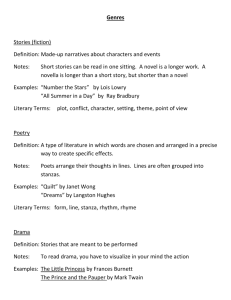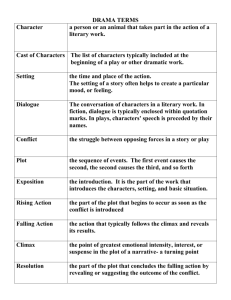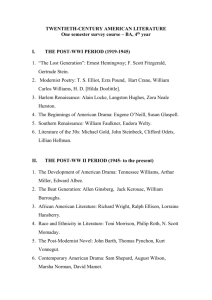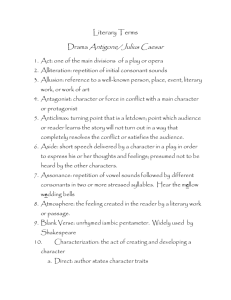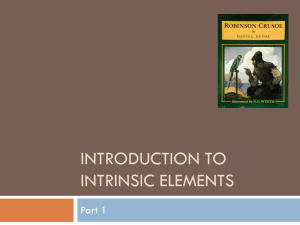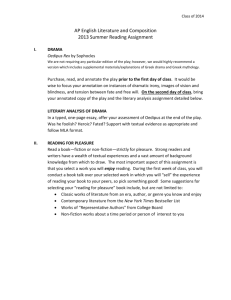DRAMA by STAAR-light - Priceless Literacy
advertisement
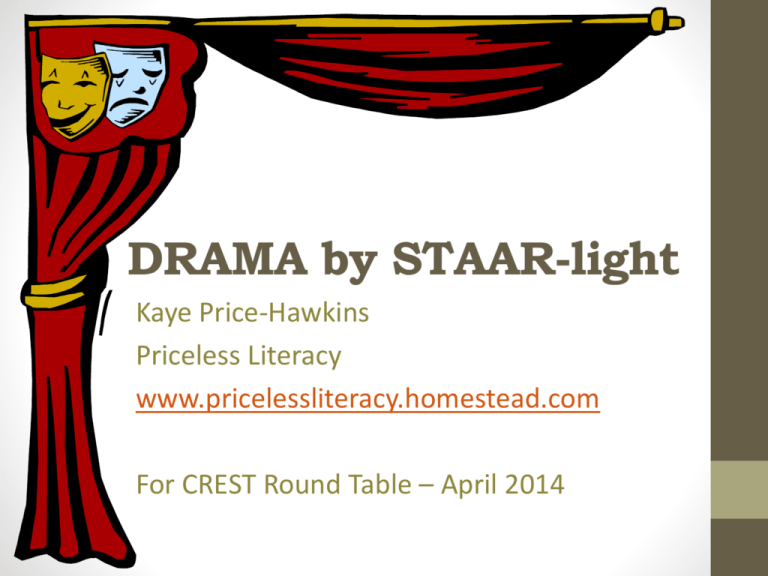
DRAMA by STAAR-light Kaye Price-Hawkins Priceless Literacy www.pricelessliteracy.homestead.com For CREST Round Table – April 2014 Understanding Drama Conventions are specific actions or techniques an actor or director employs to create a desired dramatic effect and style. • Characters the audience can relate to: • Attitudes and emotions • Relationships • Dialogue (conversation) • External & Internal conflict • Climactic Tension • Resolution The Elements of Drama • Literary elements • • • • • Plot structure Characters Exposition (www@ww) Story organization Conflict • Internal • External • • • • Suspense Theme Language Style • Technical elements • • • • • • Scenery (set) Costumes Props Lights Sound Makeup • Performance elements • • • • • Acting Character motivation Character analysis Empathy Others that are not tested Important Terms • Playwright • Dialogue • Monologues • Soliloquy • Aside • Dramatic irony (ironic) • Setting • Plot (summary) • Theme • Character • Protagonist • Antagonist • Staging (stage directions) • Excerpt • Scene • Resolution of (resolves a) conflict • Solves a problem PIN the TALE on the Person! • Draw an outline of the character(s) on the floor or on the wall. • Fill the outline with post-it notes (PINs) that describe the character • Find text evidence to support the descriptions. • Students add PINs as drama develops and character changes. Understanding Stage Directions: Foldable for “hands on” manipulative… STAGE DIRECTIONS ARE ABOUT THE CHARACTER, SETTING AND MOOD. CHARACTERS: Protagonist – main character Antagonist – conflict (and Supporting Characters) Actions Attitude Appearance Motivation SETTING: Where When (Era) Mood/Tone Impact Outside of booklet inside left side inside right side Apply this information to examples (plays that have stage directions of various kinds). Literary Plotline (“hands on” manipulative to include in their journals) Outside flaps of the Literary Plotline sentence strip shutterfold. Inside left flap | Inside center section | Inside right flap Apply this plotline to stories and plays. Academic language may be applied to the discussion in order to help students internalize the vocabulary necessary for their discussions and STAAR questions. Literary Plotline sections: STAAR QUESTIONS • Inferences • Themes • Summary • Vocabulary • Setting • Conflict • Character analysis • Traits • Actions • Interactions • Purpose: • • • • • • • Figurative language Stage directions Certain lines Props Actions Sound effects Others? • Look for examples of these kinds of questions. This power point is available: www.pricelessliteracy.homestead.com click on “power points” Handout is on the same page as the power point. #thanksforallyoudo #sharethisinfoifyouwish #blessingsfromkayeph

